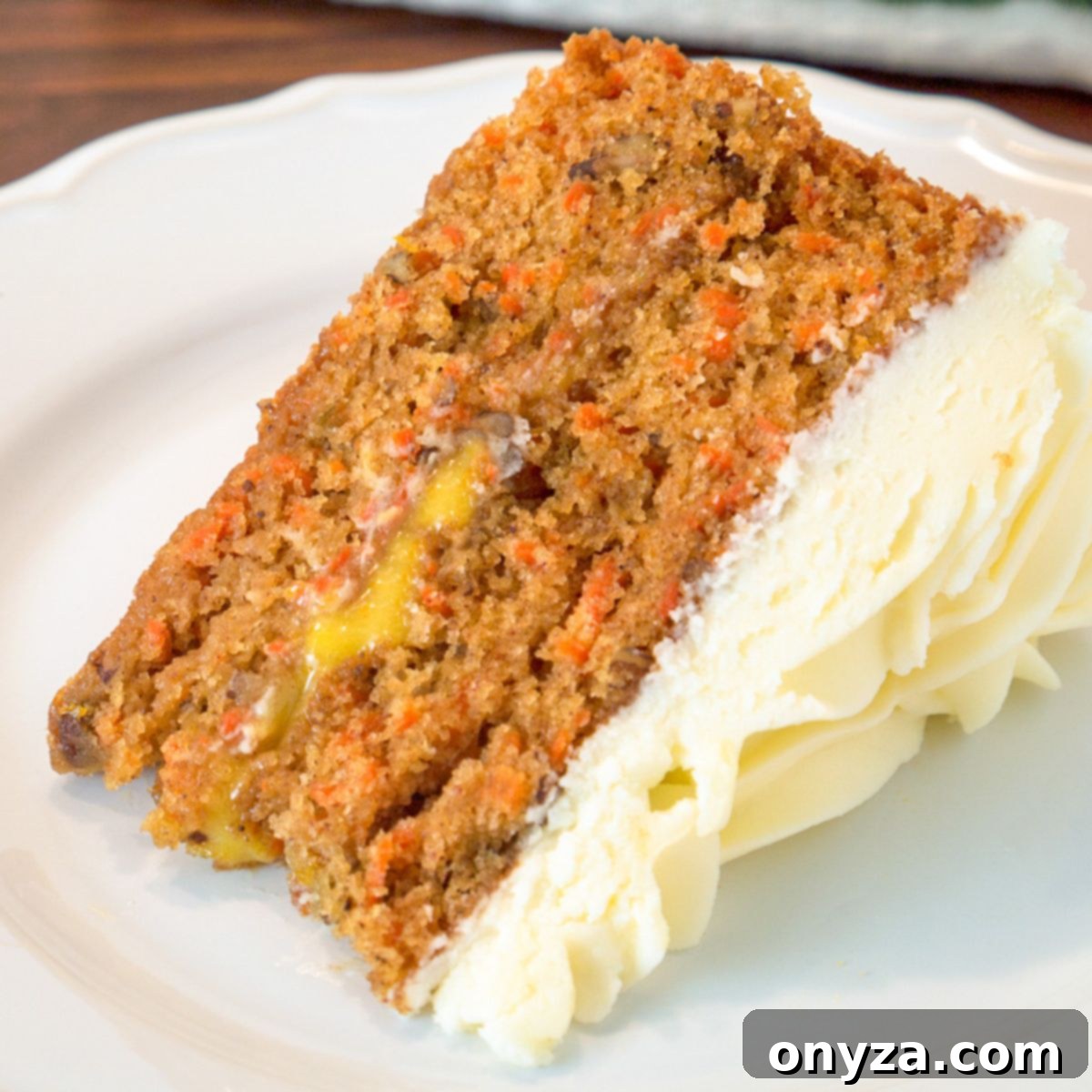Indulge in a truly exceptional dessert experience with this exquisite Carrot Cake, featuring a delightful twist: a vibrant layer of sweet-tart orange curd. Rich, moist, and perfectly spiced, this cake is surprisingly light, making it an ideal centerpiece for your Easter celebrations or any springtime gathering. Forget heavy, overly dense carrot cakes; this recipe delivers a bright, harmonious balance of flavors that will quickly become a cherished family favorite.
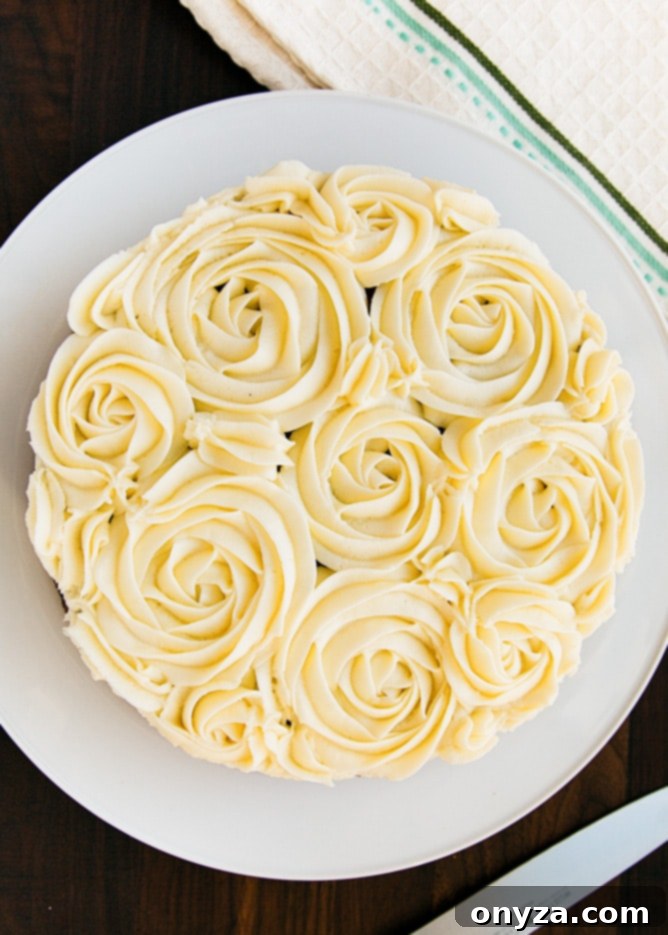
This post contains affiliate links. As an Amazon Associate, I earn a commission (at no additional cost to you) from qualifying purchases made by clicking these links. As always, all recommendations and opinions expressed are my own.
Discover the Magic of This Orange Curd Carrot Cake
There’s nothing quite like a classic carrot cake to signal the arrival of spring. Growing up, Easter always meant my mother’s delightful orange-glazed carrot cake, a beloved recipe from the Junior League of Jackson’s Southern Sideboards cookbook. Our entire family adored its comforting flavors and festive appeal.
However, one year, a happy accident led to a culinary revelation. With an abundance of homemade orange curd from a previous tartlet experiment, we decided to try incorporating it into our annual Easter cake. The result was nothing short of spectacular! The creamy, zesty curd filling elevated the cake beyond our wildest expectations, creating a new, vibrant dimension of flavor that we loved even more than the traditional glaze. After several iterations and minor tweaks, we perfected this Carrot Cake with Orange Curd, establishing a new and delicious Easter tradition.
Here’s why this unique carrot cake stands out and is destined to become a staple in your recipe collection:
- Unforgettable Flavor Profile: This carrot cake boasts a delicate balance of warm spices, a wonderfully moist and tender crumb, and just the right amount of sweet, freshly shredded carrots. The star of the show, the orange curd, introduces a bright, tangy counterpoint between each layer, cutting through the richness beautifully. It’s all harmoniously topped with a perfectly sweetened, velvety cream cheese frosting that complements without overpowering.
- Surprisingly Simple to Prepare: While this impressive dessert might look complex, the preparation can be easily broken down into manageable stages, making holiday baking stress-free. The cake batter itself comes together effortlessly, requiring only a whisk – no need to haul out your heavy stand mixer or hand mixer unless you prefer to! This simplicity, combined with the option to prep components in advance, makes it an accessible recipe for bakers of all skill levels.
- A Show-Stopping Centerpiece: Beyond its incredible taste, this carrot cake is truly a feast for the eyes. Its elegant presentation and the vibrant contrast of the orange curd peeking between layers make it a visually stunning dessert, perfect for special occasions, holiday tables, or any time you want to impress your guests with a homemade masterpiece.
Essential Ingredients for Your Carrot Cake Masterpiece
Crafting this incredible carrot cake requires a thoughtful selection of fresh, high-quality ingredients. Each component plays a crucial role in achieving the cake’s signature texture and exquisite flavor. Let’s delve into what you’ll need for each part of this culinary adventure:
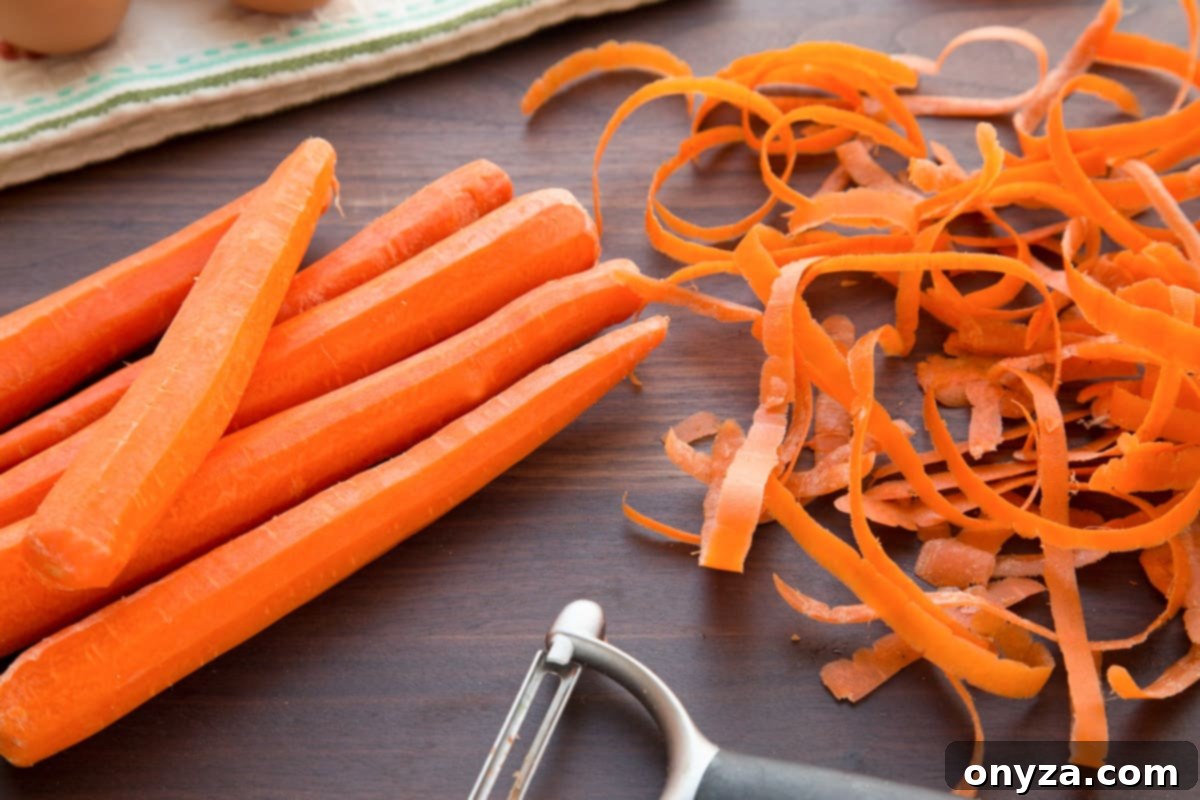
For the Perfectly Moist Carrot Cake Layers:
- All-Purpose Flour: The foundational ingredient, providing essential structure to our cake. For best results, measure flour using the “spoon and sweep” method into a dry measuring cup or, for ultimate accuracy, weigh it.
- Baking Powder and Baking Soda: These leavening agents work in tandem to give the cake its ideal rise and tender crumb. Always ensure your baking powder and soda are fresh for optimal effectiveness.
- Salt: A crucial flavor enhancer that balances the sweetness and brings out the depth of the other ingredients. We recommend using regular table salt for this recipe.
- Warm Spices: Ground cinnamon and nutmeg are the heart of classic carrot cake flavor, infusing it with cozy, aromatic notes that beautifully complement the sweet carrots and sugars.
- A Blend of Sugars. Combining light brown sugar and granulated sugar is key to both the cake’s flavor and moisture. The molasses in brown sugar adds a subtle caramel undertone and extra moisture, while granulated sugar ensures sweetness and tenderness.
- Large Eggs: Acting as a binder, eggs contribute to the cake’s structure and add richness. Always use room temperature eggs for a smoother, more emulsified batter.
- Vegetable Oil: This is the secret to a consistently moist carrot cake. Unlike butter, oil remains liquid at room temperature, keeping the cake tender and soft even when chilled.
- Fresh Carrots: The undeniable star of the show! Using fresh, whole carrots, peeled and finely shredded, guarantees the best flavor and texture. Pre-shredded carrots are often drier and lack the vibrant taste we’re aiming for.
- Chopped Pecans (Optional, but Highly Recommended): For an added layer of texture and nutty depth, chopped pecans are a fantastic inclusion. Toasting them lightly before adding them to the batter will intensify their flavor, creating a delightful contrast with the soft cake.
A Note on Shredding Carrots: Achieving the right texture for the carrots is vital. You can use the small shredding disc of a food processor for quick work or a good old-fashioned box grater for a bit of elbow grease. I personally prefer smaller carrot pieces for an even distribution in the cake. If using a food processor, a couple of short pulses after shredding can help break down any longer strands.
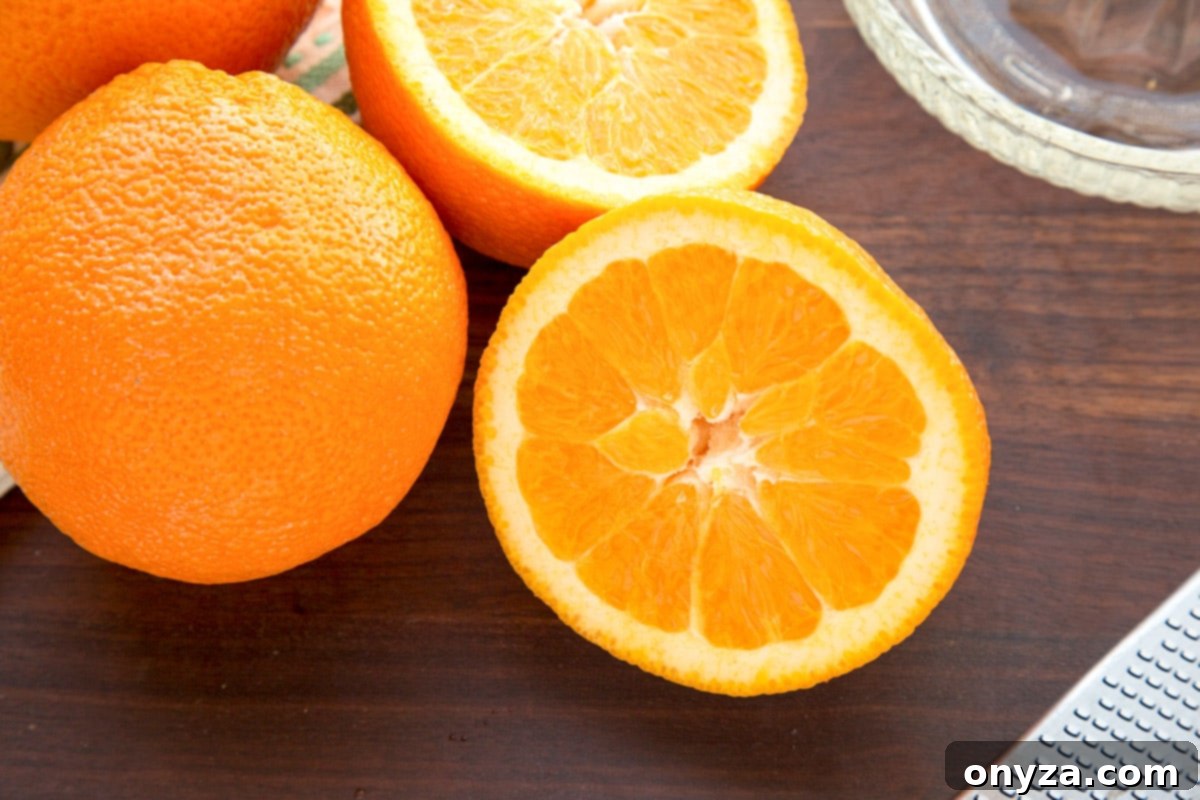
For the Bright and Tangy Orange Curd Filling:
- Fresh Oranges and Lemons: These citrus fruits form the vibrant heart of our curd. You’ll need both their zest and juice to achieve that perfect balance of sweet and tart, a bright contrast to the rich carrot cake.
- Large Egg Yolks: The magic behind the curd’s luxurious, thick, and silky-smooth texture. They also contribute a rich depth of flavor. Be sure to separate yolks cleanly from whites to ensure the curd’s purity and consistency.
- Granulated Sugar: Sweetens the curd to complement the tartness of the citrus without being cloying. It also plays a role in the curd’s thickening process, helping achieve that ideal spoonable consistency.
- Unsalted Butter: Adds a beautiful creaminess, richness, and glossy finish to the curd, rounding out the citrus notes with a velvety mouthfeel. Cut it into small cubes for easy integration.
For the Velvety Cream Cheese Frosting:
- Brick-Style Cream Cheese: Opt for brick-style cream cheese over the tub variety. Tub cream cheese often contains additives that make it spreadable but can lead to a runny or overly soft frosting. Brick cream cheese ensures your frosting will be thick, firm, and hold its shape beautifully.
- Unsalted Butter: Essential for creating a silky-smooth, spreadable, and lush frosting. Ensure your butter is softened to room temperature for seamless blending with the cream cheese.
- Vanilla Extract: A touch of pure vanilla extract adds a subtle, comforting flavor to the frosting, reminiscent of a classic cheesecake and perfectly complementing the other elements of the cake.
- Confectioner’s Sugar (Powdered Sugar): This fine sugar is key to a smooth frosting. I prefer my cream cheese frosting to be not overly sweet, allowing the cake’s flavors to shine. Sifting the sugar beforehand is crucial to prevent any lumps and guarantee a velvety texture.
Crafting the Zesty Orange Curd Filling
The secret to this carrot cake’s unique appeal lies in its vibrant orange curd filling. Preparing this component in advance is key, allowing it ample time to chill and achieve its perfect, thick consistency. I highly recommend making the curd the day before you plan to assemble your cake.
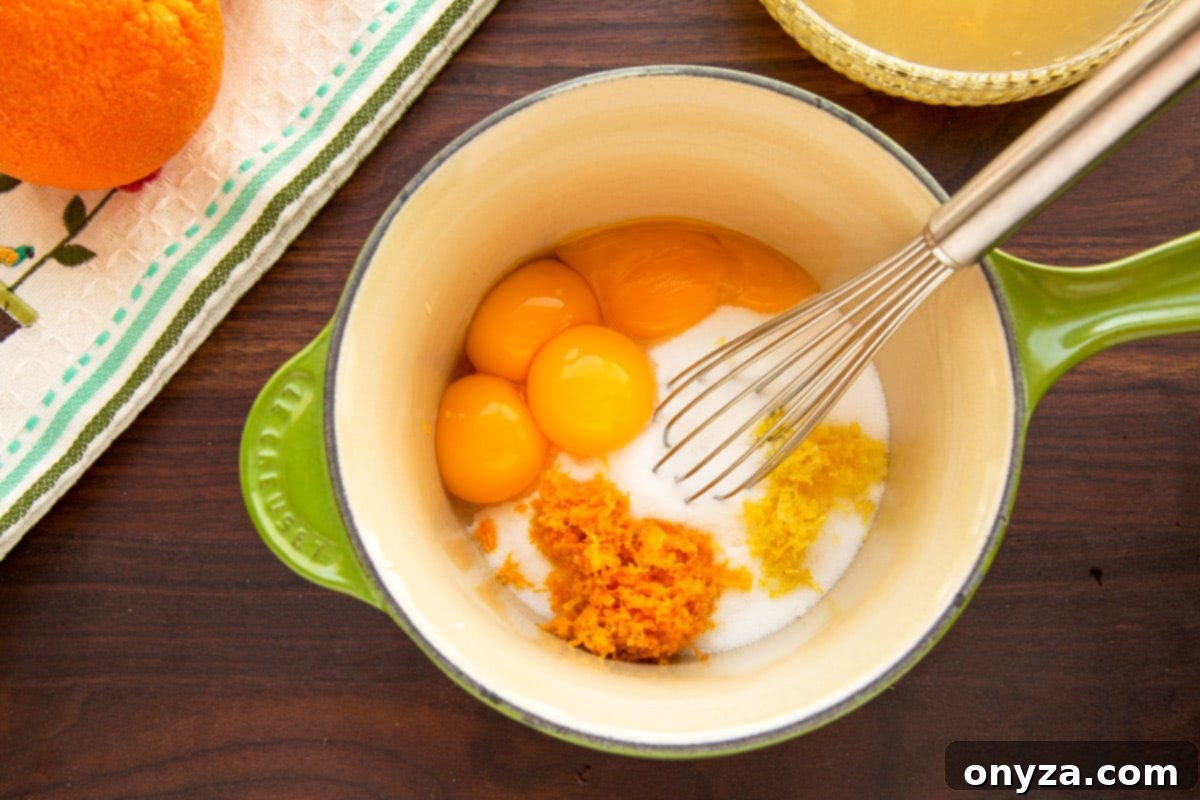
- Combine Ingredients: In a small, non-reactive saucepan (stainless steel or ceramic works best), whisk together the egg yolks, fresh citrus juices and zest, granulated sugar, and a tiny pinch of salt until thoroughly combined. The mixture should be smooth and slightly pale.
- Gently Cook the Curd: Place the saucepan over medium-low heat. It’s imperative to stir the mixture constantly with a whisk, reaching into all corners of the pan, to prevent the egg yolks from scrambling or sticking to the bottom. Continue cooking until the curd thickens significantly, enough to coat the back of a spoon and leave a clear trail when you run your finger across it. This typically takes about 8-9 minutes. Be patient and keep stirring!
- Finish with Butter: Once the curd has reached the desired thickness, remove the saucepan from the heat immediately. Add the cubed unsalted butter, stirring continuously until the butter is completely melted and incorporated. The curd will transform into a beautifully glossy, smooth, and luscious consistency.
- Cool and Chill to Perfection: Transfer the warm curd into a clean, non-reactive bowl. To prevent a skin from forming on the surface as it cools, press a piece of plastic wrap directly onto the surface of the curd. Allow it to cool at room temperature for a short while before transferring it to the refrigerator. While the curd can be used after chilling for at least 3 hours, its texture and flavor deepen considerably if allowed to chill overnight. This extended chilling time ensures optimal thickness and a more intense citrus burst.
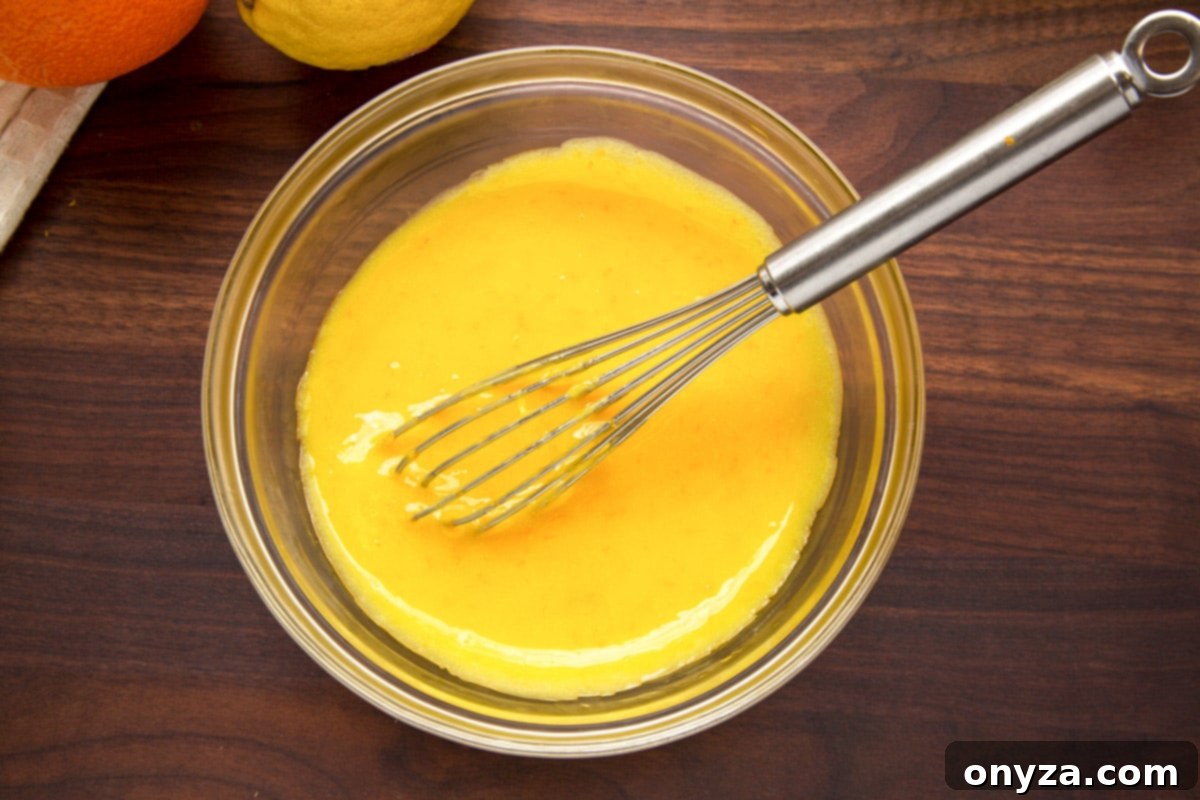
Baking the Fluffy and Flavorful Carrot Cake Layers
Creating the foundation for our delectable dessert, these carrot cake layers are designed to be moist, rich, and full of classic flavor. Follow these steps for perfect results every time:
- Prepare Your Cake Pans: You’ll need two 9×2-inch round cake pans. High-quality pans, such as Williams-Sonoma Goldtouch Pro Nonstick Cake Pans or Fat Daddio’s Anodized Aluminum Round Cake Pans, are excellent choices for ensuring even baking and easy release. Line the bottoms of both pans with parchment paper circles and lightly grease both the parchment and the sides of the pans with cooking spray. You can cut your own parchment rounds or opt for convenient pre-cut parchment circles.
- Organize Your Ingredients: For a smooth baking process, it’s best practice to separate your ingredients into “wet” and “dry.” Prepare two large mixing bowls; one for the dry ingredients and a second for the wet. Remember, the dry ingredient bowl should be large enough to eventually accommodate all the combined batter.
- Mix the Dry Ingredients: In the larger bowl, combine your all-purpose flour, baking powder, baking soda, salt, ground cinnamon, and ground nutmeg. Whisk these ingredients together vigorously for about 30 seconds or sift them to ensure they are thoroughly combined and aerated. This step is crucial for an even rise and distribution of spices.
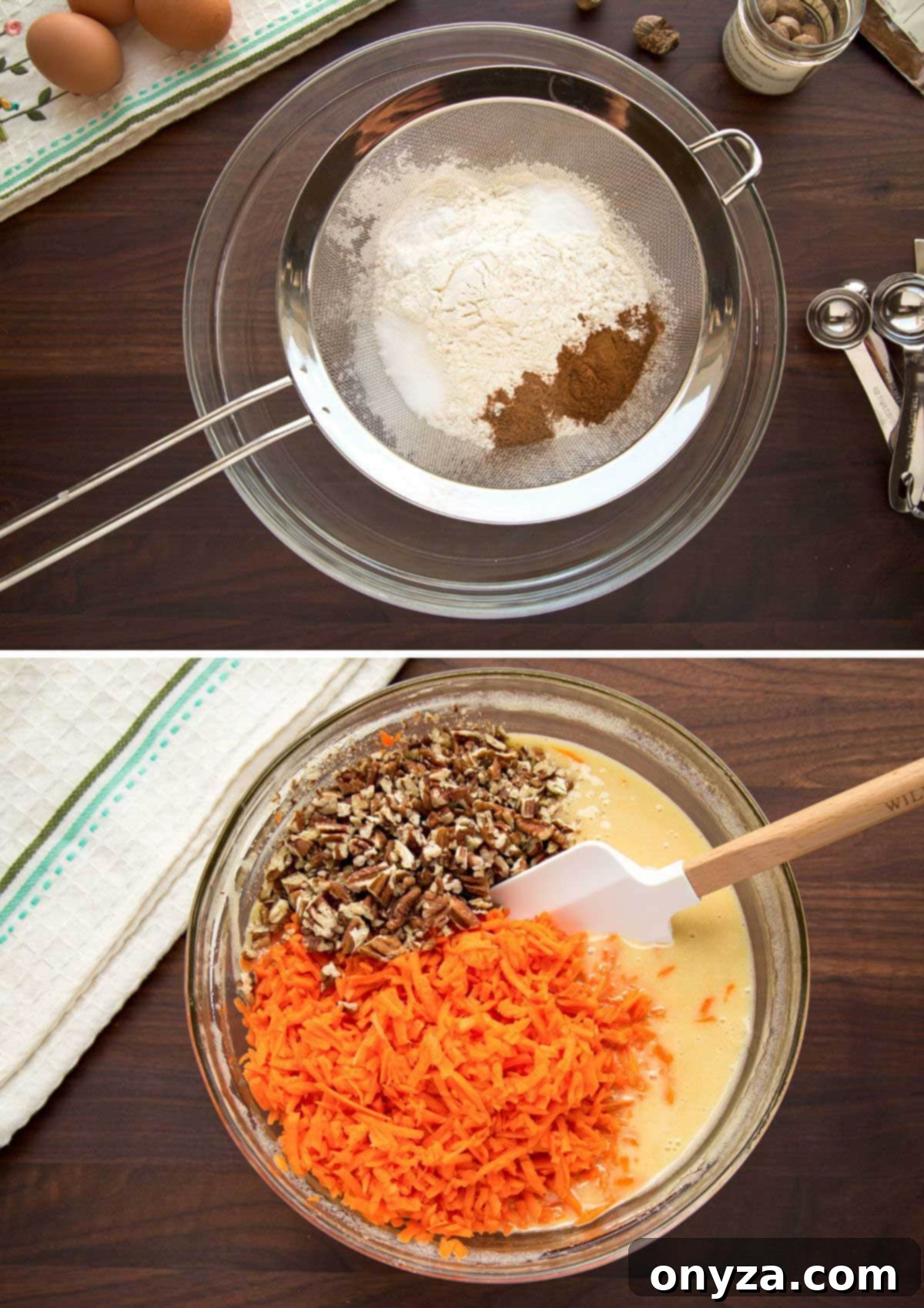
- Combine the Wet Ingredients: In the second bowl, whisk together the light brown sugar, granulated sugar, and large eggs until the mixture is thick, pale, and smooth. This could take a couple of minutes by hand, or you can use a stand mixer or hand mixer set to low speed. Gradually add the vegetable oil in a slow, steady stream while continuing to whisk until the mixture is fully emulsified and smooth. Finally, gently stir in the finely shredded carrots and, if using, the chopped pecans.
- Combine Wet and Dry Ingredients: Now, it’s time to bring everything together. Use a rubber spatula to gently fold the wet ingredients into the dry ingredients. Mix just until no streaks of flour are visible. Be very careful not to overmix the batter, as this can lead to a tough, dry cake. A few small lumps are perfectly fine.
- Bake to Perfection: Divide the prepared carrot cake batter evenly between your two greased and lined cake pans. Bake in a preheated 350°F (175°C) oven for approximately 30-35 minutes. To test for doneness, insert a wooden skewer or cake tester into the center of each cake; it should come out clean or with only a few moist crumbs attached.
- Cooling the Layers: Once baked, remove the cakes from the oven and allow them to cool in their pans on a wire rack for about 15 minutes. This settling period helps prevent the cakes from cracking when removed. After 15 minutes, carefully invert the cakes onto the wire racks, gently peel off the parchment paper, and let them cool completely at room temperature before frosting.

Whipping Up the Dreamy Cream Cheese Frosting
While I adore a good cream cheese frosting, I believe this particular carrot cake shines brightest when the frosting isn’t overly abundant. With the bright, creamy orange curd nestled between the layers, a lighter hand with the frosting on top perfectly balances the flavors without overwhelming them. It’s just enough to add that classic tang and luxurious finish. Here’s how I prepare my perfect, not-too-sweet cream cheese frosting:
- Cream Together Cheese and Butter: Start with both your brick-style cream cheese and unsalted butter at true room temperature. This is essential for a smooth, lump-free frosting. Place them in the bowl of a stand mixer fitted with the whisk attachment (or use a large bowl with a hand mixer). Whip on medium speed for about 2 minutes until the mixture is beautifully smooth, creamy, and light.
- Add Vanilla and Powdered Sugar: Stop the mixer and scrape down the sides of the bowl thoroughly with a spatula. Add the vanilla extract and then begin incorporating the sifted confectioner’s sugar. To avoid a “sugar cloud,” add the sugar in three gradual additions, mixing on low speed until each addition is just combined. Once all the sugar is in, increase the speed to medium-high and whip for an additional 3-4 minutes until the frosting is wonderfully fluffy, airy, and velvety smooth.
Make-Ahead Frosting Tip:
While I often prepare the frosting as the cake layers are cooling, it’s a fantastic component to make ahead of time, saving you valuable minutes on assembly day. Simply whip up the frosting as directed, then transfer it to an airtight container and store it in the refrigerator for up to 3 days. When you’re ready to decorate, allow the frosting to come back to room temperature—both butter and cream cheese stiffen when cold, making it hard to spread. Once it’s softened, give the frosting a quick re-whip in your mixer for a minute or two to restore its smooth, fluffy texture, making it perfect for spreading or piping.
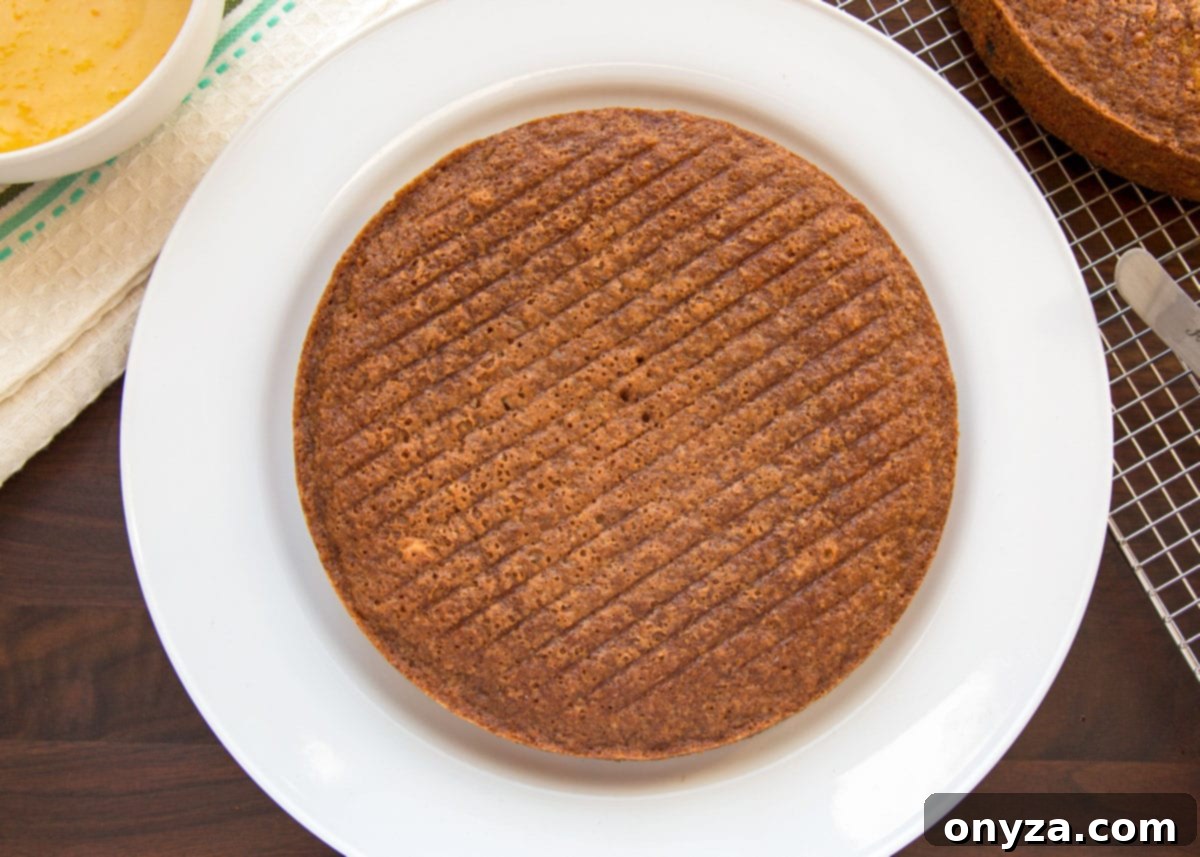
Assembling Your Show-Stopping Carrot Cake
With your cake layers cooled, orange curd chilled, and frosting ready, it’s time for the exciting part: assembling this magnificent Carrot Cake with Orange Curd. This final stage brings all the delicious elements together into a harmonious whole.
- Position the First Cake Layer: Carefully place one of your cooled carrot cake layers onto your chosen serving platter or cake stand. This will serve as the sturdy base for your culinary masterpiece.
- Spread the Orange Curd: Using an offset spatula or the back of a spoon, gently spread the chilled orange curd evenly over the base cake layer. Be sure to leave a clear 1/2-inch margin around the edges of the cake. This crucial step prevents the curd from oozing out once the second layer is placed on top, keeping your presentation neat and beautiful.
- Add the Second Layer: With care, position the second carrot cake layer directly on top of the orange curd. Gently press down on the top layer to secure it in place and create a stable, even cake.
- Frost the Cake: Now for the finishing touch! Using an offset spatula or a piping bag fitted with your desired tip, decoratively frost the top of the cake. For the elegant rosettes pictured, I used a Wilton 1M open star tip. When decorating, I find disposable pastry bags incredibly convenient for easy cleanup. If you’re piping rosettes, start from the center of the cake and work your way outwards in continuous circular motions to create a stunning floral effect.
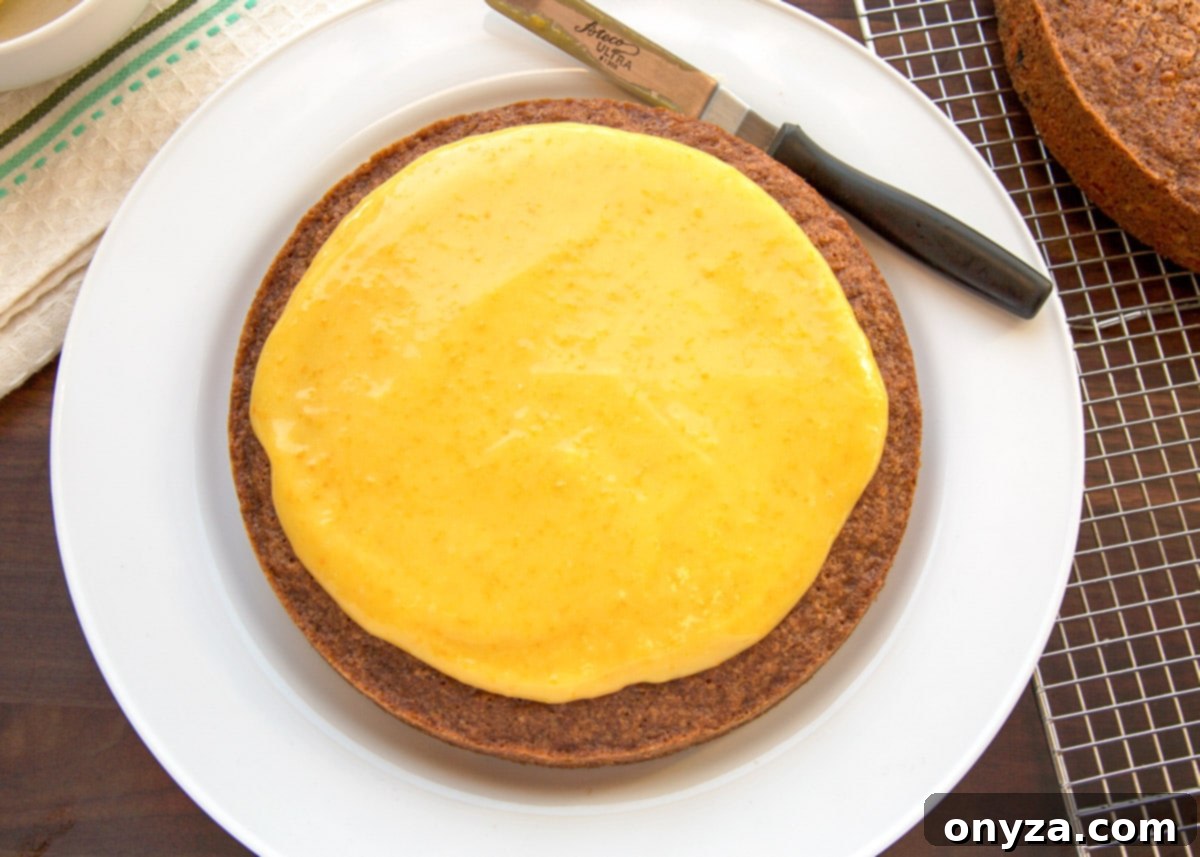
Serving and Storing Your Delightful Carrot Cake
While this cake is absolutely delicious when served fresh, it truly develops its full potential and shines brightest the day after it’s made. Allowing it to rest overnight gives the bright, citrusy notes of the orange curd ample time to deeply infuse into the moist carrot cake layers, creating a more harmonious and integrated blend of flavors. This mellowing period transforms a great cake into an extraordinary one!
To enjoy it at its peak, assemble the cake, then cover it gently and refrigerate it overnight. I find a round cake carrier to be indispensable for both storage and transport. Approximately 30 minutes before you plan to serve, remove the cake from the refrigerator to allow the frosting to soften slightly and the cake to come closer to room temperature, enhancing its texture and flavor. Should you find yourself with any delicious leftovers, they will keep beautifully in the refrigerator for up to 3 days, ensuring you can savor this special treat for longer.
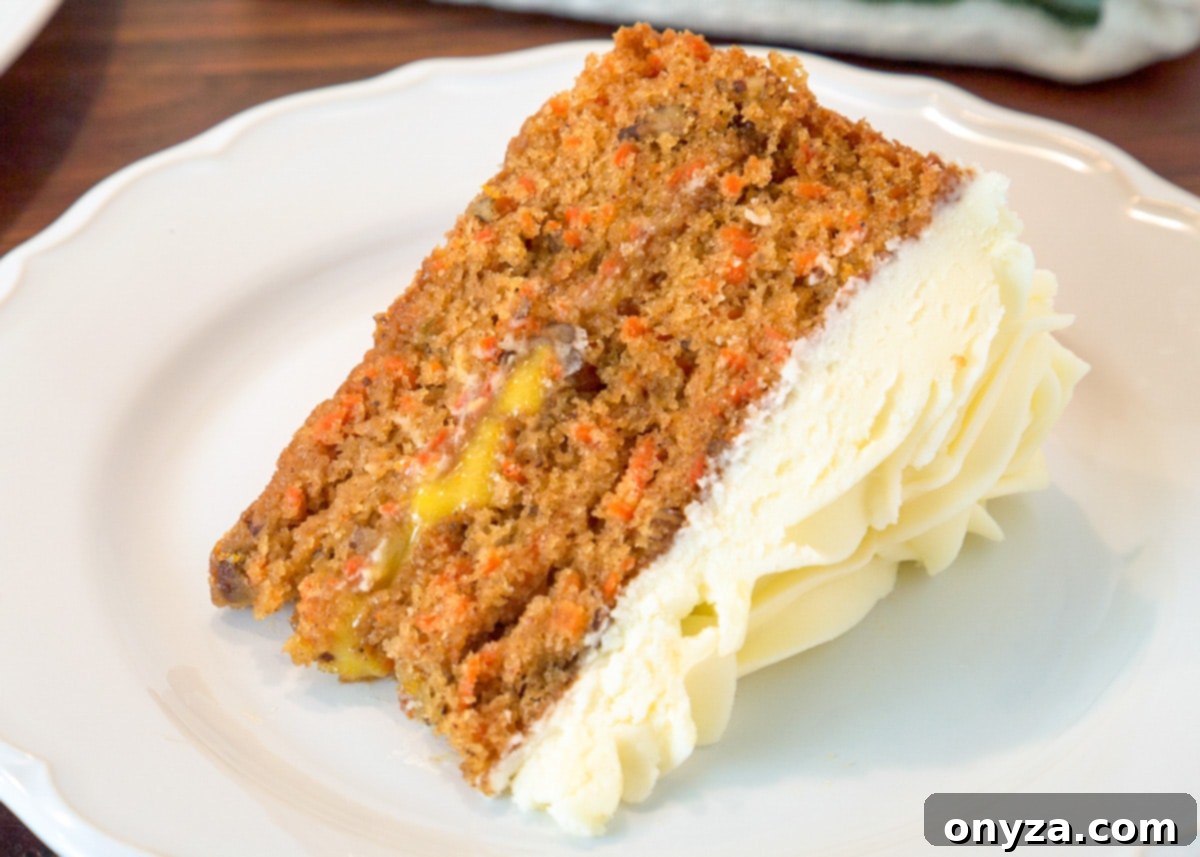
An Important Note About the Curd Filling:
Similar to the orange glaze that inspired this recipe, the orange curd will naturally soak into the cake layers somewhat as the cake rests. On the day after assembly, you might not observe an extremely thick, distinct layer of curd when you slice into the cake. Instead, what you will discover is that the entire center of the cake has developed a wonderfully lovely and bright orange flavor, permeating every bite. Through extensive experimentation, I found that attempting to create an overly thick curd layer for a more discernible visual separation actually detracted from the cake’s overall balance. Much like an excessive amount of cream cheese frosting, too much curd can become overpowering, overshadowing the delicious essence of the carrot cake itself. The subtle infusion is truly the key to its success.
Explore More Delicious Spring Dessert Recipes
If you’re looking for more delightful treats to celebrate the season or simply satisfy your sweet tooth, here are some other spring-inspired dessert recipes you’ll love:
- Vanilla Pound Cake (Perfect for Strawberry Shortcake or a Trifle!)
- No-Bake Cheesecake Cups with Graham Crumble Topping
- Strawberry Rice Krispie Treats
- Lemon Cream Mixed Berry Tart
CRAVING MORE? Don’t miss out on our latest recipes and culinary news! Subscribe to our newsletter and connect with us on Facebook, Pinterest, and Instagram.
Carrot Cake with Orange Curd Recipe
This Carrot Cake with Orange Curd promises a moist cake packed with the nutty crunch of pecans, perfectly complemented by a sweet-tart citrus filling. Topped with smooth cream cheese frosting, this layer cake is sure to impress as an Easter dessert or for any spring gathering.
Prep Time: 3 hours 40 minutes
Cook Time: 30 minutes
Total Time: 3 hours 33 minutes
Servings: 12 servings
Ingredients
For the Orange Curd
- 4 large egg yolks
- ½ cup granulated sugar
- 1 tablespoon grated orange zest
- 1 teaspoon grated lemon zest
- ¼ cup orange juice, preferably freshly-squeezed
- 1 tablespoon fresh lemon juice
- pinch salt
- 4 tablespoons unsalted butter, cut into small pieces
For the Cake
- 2 cups all-purpose flour (250 grams)
- 2 teaspoons baking powder
- 1 teaspoon baking soda
- 1 teaspoon salt
- 1-1/2 teaspoons ground cinnamon
- ½ teaspoon ground nutmeg
- ½ cup light brown sugar, lightly packed
- 1-1/2 cups granulated sugar
- 4 large eggs
- 1-1/4 cups vegetable oil
- 3 cups finely-shredded carrots (about 1 pound of whole carrots, peeled; use the small holes of a box grater or the fine-shredding disc of a food processor to shred)
- ½ to ¾ cup chopped pecans (optional, but recommended)*
For the Cream Cheese Frosting
- 12 ounces brick-style cream cheese, room temperature
- 12 tablespoons unsalted butter, room temperature
- ½ teaspoon vanilla extract
- 2 cups sifted confectioners sugar
Instructions
Make the Orange Curd
- In a small saucepan, whisk together all ingredients except for butter, until combined. Cook over medium-low heat, stirring constantly, until curd is thick enough to coat the back of a spoon, about 8-9 minutes. Remove from heat and stir in butter a few pieces at a time, until melted and smooth.
- Transfer curd to a non-reactive bowl, place a piece of plastic wrap directly onto the surface of the curd to prevent a skin from forming, and refrigerate until well-chilled, at least 3 hours, or overnight.
Make the Cake
- Preheat oven to 350 degrees F (175°C) with rack in the middle position. Line the bottoms of two 9-inch cake pans with parchment rounds and lightly spray the papers and sides of the pan with cooking spray.
- In a large bowl, sift or whisk together the flour, baking powder, baking soda, salt, cinnamon, and nutmeg. Set aside.
- In another large bowl, whisk together eggs and sugars until thick and smooth (you can also use a hand or stand mixer here). Slowly add the oil in a steady stream, while whisking, until fully combined and emulsified. Stir in carrots and pecans (if using). Fold wet ingredients into the dry ingredients until no streaks of flour remain.
- Divide cake batter evenly between the two prepared pans. Bake 30-35 minutes, until a cake tester inserted into the center comes out clean. Remove from oven and let cakes cool in the pans for about 15 minutes. Invert cakes from pans onto wire racks to continue cooling, peeling off the parchment rounds. Cool completely.
Make the Cream Cheese Frosting
- In the bowl of a stand mixer fitted with the whisk attachment, or in a large bowl with a hand mixer, whip together cream cheese and butter until smooth, about 2 minutes. Mix in the vanilla.
- Add confectioner’s sugar in 3 additions, mixing on low speed until incorporated, and scraping the bowl between additions. Beat on medium-high speed until smooth, about 2-3 minutes more.
Assemble the Cake
- Place one cake layer on a platter. Spread the cake with the orange curd, leaving a 1/2-inch border. Top with the second cake layer.
- Decoratively pipe or spread cream cheese frosting onto the top of the cake. Serve, or cover and refrigerate for storage. Cake is better on the second day. Remove from the refrigerator 30 minutes prior to serving to allow frosting to soften a bit.
Notes
- *My family enjoys a prominent pecan flavor in carrot cakes, so I generally use ¾ cup chopped nuts. For a lighter density of nuts, use ½ cup.
- This recipe makes enough cream cheese frosting to decoratively pipe the top of the cake, as I’ve done here. To make rosettes, use a Wilton 1M tip, piping swirls in a circular pattern from the center of the cake, outward.
- The entire cake can be made and assembled a day in advance and stored in the refrigerator. If making ahead and storing, let the cake sit out at room temperature for about 30 minutes before serving.
- Recipe inspired by “Orange-Glazed Carrot Cake” from the Southern Sideboards cookbook (Junior League of Jackson, 1978).
Nutrition Estimate
Serving: 1 slice | Calories: 513kcal | Carbohydrates: 68g | Protein: 9g | Fat: 23g | Saturated Fat: 14g | Cholesterol: 163mg | Sodium: 536mg | Potassium: 323mg | Fiber: 1g | Sugar: 48g | Vitamin A: 6005IU | Vitamin C: 5.9mg | Calcium: 170mg | Iron: 1.7mg
Nutrition information is automatically calculated, so should only be used as an approximation.
About Our Recipes
Please note that our recipes have been developed using the US Customary measurement system and have not been tested for high altitude/elevation cooking and baking.
